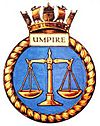HMS Umpire (N82) facts for kids

HMS Umpire
|
|
Quick facts for kids History |
|
|---|---|
| Builder | Chatham Dockyard, |
| Laid down | 1 January 1940 |
| Launched | 30 December 1940 |
| Commissioned | 10 July 1941 |
| Fate | Sunk in collision 19 July 1941 |
| Badge |  |
| General characteristics | |
| Displacement |
|
| Length | 60 m (196 ft 10 in) |
| Beam | 4.90 m (16 ft 1 in) |
| Draught | 4.62 m (15 ft 2 in) |
| Propulsion |
|
| Speed |
|
| Complement | 31 |
| Armament |
|
HMS Umpire (N82) was a special type of submarine called a U-class submarine. It was built for the Royal Navy in the United Kingdom at Chatham Dockyard. Sadly, just nine days after it was officially ready for duty in July 1941, it sank in an accident. Twenty-two brave sailors lost their lives in this tragic event.
Contents
The Short Life of HMS Umpire
HMS Umpire was on its way from Chatham to join a group of submarines called the 3rd Submarine Flotilla in a place called Dunoon. The plan was for the submarine to complete a training patrol in the North Sea. After that, it would head to the Mediterranean Sea for more duties.
The Journey Begins
The submarine was under the command of Lieutenant Mervyn Wingfield. It stopped overnight at Sheerness and then joined a group of ships traveling together, known as a convoy, heading North.
Engine Trouble and Collision
During its journey, one of the submarine's two diesel engines stopped working. This meant Umpire could not keep up with the convoy. Its propellers were powered only by electric motors, which were slower.
Around midnight, the convoy Umpire was with passed another convoy heading South. This happened about 12 nautical miles (22 km) off Blakeney, Norfolk. Usually, ships pass each other on their left side (port to port). But this time, the convoys passed on their right side (starboard to starboard), which was unusual.
Because of the danger from German E-boats (fast attack boats), no ships in either convoy were showing any lights. An armed fishing boat, called a trawler, named Peter Hendriks was in the southbound convoy. It accidentally hit Umpire, causing the submarine to sink in 18 meters of water.
Surviving the Sinking
When Umpire sank, four crew members were on the bridge, which is the control area on top. These included Lieutenant Wingfield, the navigator, and two lookouts. Only Wingfield survived the cold water and was rescued by the trawler.
Several other crew members also survived. They managed to escape from the sunken submarine. Some escaped through the conning tower, which is a small tower on top of the submarine. Others used an escape hatch in the engine room. Most of them were wearing special breathing equipment called DSEA.
Chief ERA Killen, an Engine Room Artificer (a type of engineer), was very brave. He received a British Empire Medal for his actions. He left the submarine wearing his DSEA to check if anything was blocking the engine room hatch. Then, he went back into the engine room to help other crew members escape. He stayed there until everyone else had gotten out safely. In total, 16 crew members successfully escaped, but 22 were lost.
A Survivor's Later Command
One of the survivors from Umpire was Lieutenant Edward Young. He later became the commander of another submarine, HMS Storm.
A Protected Site
The wreck of HMS Umpire is now a protected place. This means it is kept safe under a law called the Protection of Military Remains Act 1986.

